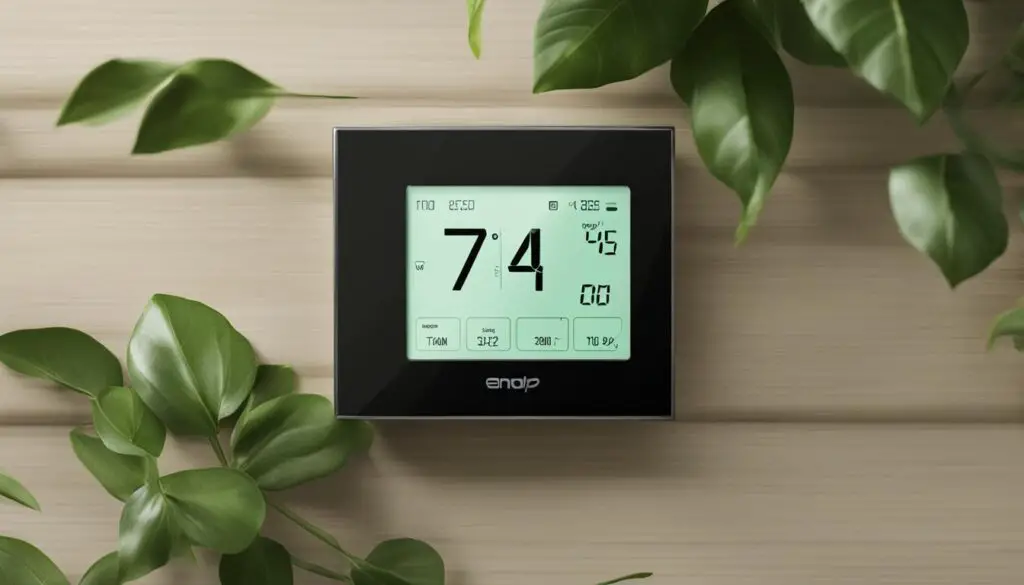Welcome to my article on home automation for climate control! In today’s world of smart home technology, it’s easier than ever to achieve optimal comfort and energy efficiency with the help of a climate control system. By leveraging home automation devices, such as smart thermostats, homeowners can take control of their home’s temperature and create a more efficient living environment.
Table of Contents
Key Takeaways:
- Home automation devices offer the convenience of managing climate settings remotely.
- Smart thermostats provide remote control capabilities, allowing homeowners to adjust temperature settings from anywhere.
- Energy efficiency is achieved through personalized schedules and optimized usage of heating and cooling systems.
- Integration with smart home ecosystems enhances convenience and energy efficiency.
- The future of smart climate control lies in AI-driven systems, wearable device integration, and renewable energy sources.
Advantages of Smart Thermostats
Smart thermostats offer numerous advantages, including remote control capabilities, energy efficiency, and cost savings. With the ability to control your home’s temperature from anywhere using your smartphone, laptop, or smartwatch, smart thermostats provide unparalleled convenience and flexibility.
Not only do smart thermostats allow you to adjust the temperature on the go, but they also offer personalized scheduling features. This means that you can create customized temperature settings based on your daily routine, ensuring that your home is always comfortable when you arrive and helping you optimize energy usage.
By optimizing energy usage, smart thermostats contribute to significant cost savings. According to a study conducted by the U.S. Environmental Protection Agency, homeowners can save up to 10% annually on heating and cooling costs by using programmable thermostats, which are a key feature of smart thermostats. Imagine the potential savings you can achieve with the added convenience and advanced features of a smart thermostat!
| Advantages | Description |
|---|---|
| Remote Control | Control your home’s temperature from anywhere using your smartphone, laptop, or smartwatch. |
| Personalized Schedules | Create customized temperature settings based on your daily routine for optimal comfort and energy efficiency. |
| Energy Efficiency | Optimize energy usage and reduce heating and cooling costs by up to 10% annually. |
| Cost Savings | Save money on utility bills by using smart thermostats to regulate your home’s temperature. |
With smart thermostats, you have the power to control your home’s climate with ease, all while enjoying the benefits of energy efficiency and cost savings. Make the switch to a smart thermostat today and experience a more convenient and sustainable way of living.

Energy Efficiency and Savings with Smart Thermostats
Smart thermostats play a crucial role in enhancing energy efficiency and achieving substantial savings on utility bills. By intelligently learning homeowners’ routines and optimizing temperature settings, smart thermostats ensure optimal comfort while reducing energy consumption.
Automatic Temperature Adjustment
One of the key features of smart thermostats is their ability to automatically adjust temperature settings based on homeowners’ habits and preferences. Through advanced algorithms and machine learning capabilities, these devices analyze energy usage patterns and make real-time adjustments to optimize energy efficiency. This technology enables homeowners to save on heating and cooling costs without sacrificing comfort.
Significant Energy Savings
Homeowners using smart thermostats have reported substantial energy savings, resulting in lower utility bills. According to studies, these devices can save an estimated $131 to $145 per year in energy costs, making them a valuable investment for any household.
Insights into Energy Usage
In addition to reducing energy consumption, smart thermostats provide insightful data on energy usage patterns. By tracking and analyzing energy consumption in real-time, homeowners can gain valuable insights into their energy usage habits. This information empowers them to make informed decisions, adopt energy-saving practices, and further optimize their energy usage.
With the ability to observe trends and patterns, homeowners can identify potential energy waste areas and take necessary steps to address them. By making adjustments and implementing energy-saving strategies, such as setting personalized schedules or utilizing energy-efficient settings, homeowners can maximize their energy efficiency and reduce utility bills.

Smart thermostats are a cost-effective and practical solution for achieving energy efficiency and reducing utility bills. By seamlessly integrating into a smart home ecosystem, these devices offer convenience, comfort, and long-term energy savings. With their advanced features and intelligent capabilities, smart thermostats are shaping the future of climate control and paving the way for a more sustainable lifestyle.
Integration of Smart Thermostats with Smart Home Ecosystems
Smart thermostats play a crucial role in the integration of smart home ecosystems, allowing homeowners to effortlessly control their climate settings alongside other smart home devices. This seamless integration offers unparalleled convenience and enhances energy efficiency, creating a comfortable and sustainable living environment.
One example of this integration is the synchronization between smart thermostats and smart shades. By working in harmony, these devices can automatically adjust the amount of natural light entering a room, helping regulate temperature and maximize energy usage.
Through this synchronization, homeowners can experience the perfect climate control, even when they are away. Picture a scenario where you are returning home on a hot summer day, and your smart home ecosystem has already adjusted the temperature to your liking, ensuring a comfortable and welcoming environment as soon as you step through the door.
A smart thermostat integrated with a smart home ecosystem provides homeowners with the ability to monitor and control their climate settings remotely. Imagine being able to adjust the temperature of your home while you’re at work or on vacation, ensuring optimal comfort and energy efficiency at all times.
This integration goes beyond convenience. It also allows homeowners to optimize their energy usage, contributing to a greener and more sustainable future. By seamlessly incorporating smart thermostats into the larger smart home ecosystem, homeowners have the power to create a climate-conscious living space that aligns with their values.
Benefits of Integration:
- Convenient control over climate settings alongside other smart home devices
- Enhanced energy efficiency through synchronization with smart shades
- Remote monitoring and control for optimal comfort
- Opportunity to reduce energy consumption and contribute to a sustainable future
With smart home integration, homeowners can truly experience the convenience, energy efficiency, and personalized comfort that smart thermostats offer. As technology continues to advance, the integration of smart thermostats with smart home ecosystems will undoubtedly play a pivotal role in shaping the future of climate control.
The Future of Smart Climate Control
The future of climate control is an exciting realm of possibilities, driven by advancements in technology and a focus on sustainability. As we strive to create a greener and more sustainable future, AI-driven climate control systems, wearable device integration, and renewable energy sources will play pivotal roles in revolutionizing how we manage and optimize our home environments.
AI-driven climate control systems are poised to transform the way we maintain comfortable temperatures in our homes. These intelligent systems will utilize data such as user preferences, weather forecasts, and room-specific information to automatically adjust temperature settings. By leveraging AI algorithms, these systems can learn from our usage patterns and make precise adjustments to maximize energy efficiency and comfort.
Wearable device integration will take smart climate control to the next level, offering personalized experiences based on individual needs. By syncing with wearable devices such as smartwatches or fitness trackers, these systems will be able to monitor and adjust temperature settings in real-time. Whether it’s recognizing when someone is feeling too hot or too cold, wearable device integration will ensure that climate control is tailored to each individual’s preferences and comfort levels.
With AI-driven climate control and wearable device integration, homes of the future will be able to create customized comfort for each inhabitant, all while optimizing energy consumption and reducing environmental impact.
Furthermore, the integration of smart thermostats with renewable energy sources offers a significant step towards a sustainable future. By harnessing the power of solar panels, wind turbines, or other renewable energy technologies, smart thermostats can be powered by clean and renewable sources, reducing reliance on fossil fuels. This integration not only contributes to a greener environment but also helps homeowners save on energy costs and reduce their carbon footprint.
Overall, the future of smart climate control holds immense potential for creating a sustainable and optimized living environment. AI-driven climate control systems, wearable device integration, and the utilization of renewable energy sources will pave the way for a more comfortable, energy-efficient, and eco-friendly future.
Advantages of the Future of Smart Climate Control:
- Customized temperature settings based on user preferences and real-time data
- Reduced energy consumption and cost savings
- Enhanced comfort and personalized experiences through wearable device integration
- Contribution to a greener and more sustainable future through renewable energy sources
Conclusion
Home automation for climate control, specifically with the use of smart thermostats, offers numerous benefits. By leveraging smart home technology, homeowners can enjoy the convenience of remote control capabilities, allowing them to manage their home’s climate from anywhere using their smartphones or other devices.
One of the key advantages of smart thermostats is their energy efficiency, which leads to significant cost savings. These devices learn homeowners’ routines and automatically adjust temperature settings to optimize energy usage. As a result, homeowners can reduce their utility bills while still maintaining a comfortable living environment.
Moreover, the integration of smart thermostats into a larger smart home ecosystem enhances convenience and further enhances energy efficiency. When combined with other smart home devices, such as smart shades, smart thermostats can work in sync to regulate temperature and natural light, creating an optimal living space.
As technology continues to advance, we can expect even more intelligent climate control systems that are driven by AI, integrated with wearable devices, and utilize renewable energy sources. Embracing these advancements will not only lead to enhanced comfort and convenience but also contribute to a more sustainable future by reducing energy consumption and reliance on traditional power sources.
FAQ
What is home automation for climate control?
Home automation for climate control involves using smart home technology to remotely control and manage your home’s temperature and climate settings.
What are smart thermostats, and what advantages do they offer?
Smart thermostats are home automation devices that allow homeowners to control their home’s temperature remotely. They offer advantages such as remote control capabilities, energy efficiency, and cost savings.
How do smart thermostats contribute to energy efficiency and savings?
Smart thermostats optimize energy usage by learning homeowners’ routines and automatically adjusting temperature settings. This optimization can result in significant savings on heating and cooling costs, with homeowners reporting an estimated $131-$145 per year in energy savings.
Can smart thermostats be integrated into a larger smart home ecosystem?
Yes, smart thermostats can be seamlessly integrated into smart home ecosystems. This integration allows homeowners to control their climate settings along with other smart home devices, enhancing convenience and further optimizing energy usage.
What does the future hold for smart climate control?
The future of smart climate control involves advancements such as AI-driven systems, integration with wearable devices, and the use of renewable energy sources. These advancements will lead to even more intelligent climate control systems, personalized adjustments based on individual needs, and a greener and more sustainable future.


